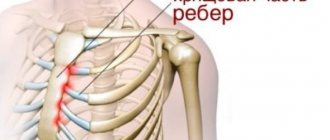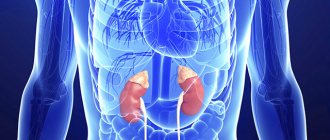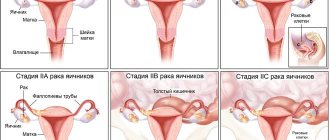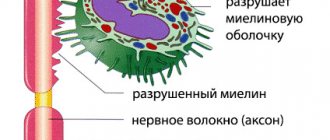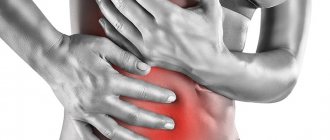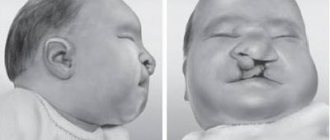Cephalgic syndrome is one of the most serious complications of cervical osteochondrosis with the development of pathology of narrowing of the posterior vertebral arteries. With prolonged destruction of the intervertebral discs, gradual degeneration of the vascular openings in the spinous processes of the vertebrae occurs. This condition deforms the vertebral arteries, causing them tortuosity and significant narrowing of the internal lumen.
When the blood supply to the posterior structures of the brain deteriorates, primary vestibulo-cephalgic syndrome develops, which reduces mental performance, causes constant drowsiness and muscle weakness. As the condition of the cerebral structures deteriorates, degeneration of the vestibular apparatus begins, for the blood supply of which the posterior vertebral arteries are also responsible. In this condition, the patient begins to experience hearing loss and the appearance of various auditory effects (noise and ringing in the ears, rustling and other extraneous sounds).
Atactic cephalgic syndrome is a pathological condition in which there is instability in the Romberg position, unsteadiness of gait, a constant feeling of severe dizziness, disorientation in space, etc. The appearance of such symptoms is a reason to urgently seek medical help. it is necessary to restore the impaired blood supply to the brain structures as quickly as possible. If this is not done on time, ischemic stroke, paralysis and other negative consequences may develop.
If you have cephalgic syndrome and the pharmacological medications prescribed by your doctor do not save you from constant debilitating headaches, we advise you to reconsider your choice of treatment methods. The fact is that with the help of manual therapy methods it is possible to eliminate the cause of the development of cephalgic syndrome - narrowing of the posterior vertebral arteries. By restoring normal blood supply to the posterior cerebral structures, the patient will feel a significant improvement in his condition. Headaches and dizziness, nausea and weakness, depression and decreased mental performance will completely disappear. A full life will return, filled with joy and freedom from headache attacks.
If you are located in Moscow, you can take advantage of our offer and make an appointment for a free appointment with a doctor. You can consult a neurologist and vertebrologist. These doctors will be able to make an accurate diagnosis and give individual recommendations for effective and safe treatment of cephalgic syndrome.
Risk factors
Risk factors include:
- Birth trauma in newborns.
- Various skull injuries.
- Complex infectious diseases.
- Acute or chronic drug intoxication.
- Increased background radiation.
- Lack of vitamins and microelements in the body.
- Bad habits.
- Heredity.
As you can see, vestibulo atactic syndrome accompanies many diseases, so it should not be underestimated. The symptoms of this pathology are a consequence of more serious diseases associated with brain dysfunction, which in advanced forms lead to disability and even death.
Changes in the motor functions of the body are associated with age-related disorders of the functioning of the musculoskeletal and vestibular apparatus
Causes
Vestibulo-atactic syndrome is a manifestation of a number of pathological processes. The most common among them are:
- Traumatic brain injury,
- Cerebrovascular accident,
- Cerebral palsy,
- Hydrocephalus,
- Hypertension,
- Atherosclerotic lesion of large cerebral arteries,
- Malignant or benign neoplasms in the brain,
- Autoimmune diseases - multiple sclerosis,
- Extracerebral tumors
- Brain cell atrophy
- Severe intoxication,
- Brain hemorrhages
- Infections,
- Intrauterine developmental disorder of the skull,
- Hepatitis,
- Avitaminosis,
- Ear diseases,
- Vestibular neuritis,
- Labyrinthitis, labyrinthine infarction,
- Meniere's disease,
- Basilar migraine,
- Cervical osteochondrosis,
- Psychogenic disorders,
- Cardiopsychoneurosis,
- Encephalitis.
Most often, vestibulo-ataxic syndrome occurs in patients with various neurological ailments. Its development can be provoked by anxiety, stress, nervousness, emotional outburst, psycho-emotional exhaustion, and physical fatigue. The first clinical signs of the disease remain mild for a long time. As the pathological process progresses, serious problems with coordination of movements arise.
The vertebrobasilar system unites the vertebral and central arteries of the brain, supplying blood to its stem structures. Discirculatory disorders that occur in the human body under the influence of endogenous or exogenous factors lead to hypoxia and ischemia of brain tissue. The high prevalence of the syndrome and the variety of its clinical forms are due to the high sensitivity of stem formations to oxygen starvation. Oxygen deficiency is the cause of disruption of the energy supply to nerve cells and the interaction of the brain with other parts of the central nervous system. When there is insufficient oxygen supply through the bloodstream to the brain, nerve cells die. The toxic effects of certain substances enhance this process. Functional disorders occur in various parts of the brain.
Persons most susceptible to developing the syndrome:
- Those who suffered a skull injury during childbirth,
- Having suffered acute infectious diseases,
- Those exposed to radiation
- Having bad habits
- Neglecting proper nutrition with sufficient amounts of vitamins and microelements in the diet,
- With a genetic predisposition,
- Elderly people with age-related disorders in the functioning of the vestibular apparatus.
Vestibulo-ataxic syndrome is a serious illness that requires urgent medical attention. Only timely diagnosis and proper treatment will increase patients’ chances of recovery. Otherwise, the pathology can lead to disability and even death.
Reasons for development
How does vestibulo-atactic syndrome manifest? Chronic circulatory failure of acquired or congenital form occurs in the vertebrobasilar arterial layers.
In addition, the phenomenon of vestibular-atactic syndrome is associated with changes in frontal stem cells, normal pressure hydrocephalus, cortical atrophy, hypertension, atherosclerosis, and osteochondrosis.
The immediate causes of motor and coordination problems are:
- chronic circulatory failure (ischemia);
- cerebellar dysfunction;
- frontal pathology;
It cannot be considered as an independent disease. The disorder is always a consequence of more serious pathologies - most often ischemia (chronic anemia) of the brain.
In some cases, dizziness and impaired motor function are signs of natural age-related disorders associated with the functioning of the musculoskeletal and vestibular system.
Possible complications
Lack of timely treatment, an incorrect diagnosis, or a medical error made during the formation of a therapeutic course can lead to the development of the following complications and negative consequences for the health and life of a patient with vestibulopathic disorder:
- development of ischemic cerebral vascular disease, if it was not yet present at the time of the onset of musculoskeletal dysfunction;
- inability to lead a full and active lifestyle;
- complete or partial loss of ability to work;
- cerebral stroke;
- atherosclerosis of blood vessels supplying brain tissue;
- the development of dementia, which can occur in a person of any age group;
- disability, dependence on the help of loved ones, bedridden or wheelchair-bound;
- physical inability to service one’s own physiological needs;
- the development of a mental disorder that occurs against the background of depletion of the cerebral cortex and degenerative processes in its tissues.
Vestibulopathic disorder, which is a chronic syndrome of cerebrovascular accidents, is a dangerous pathological condition of brain tissue.
The disease leads to disruption of the musculoskeletal system, lack of normal coordination of the upper and lower extremities, which is especially pronounced during walking. Timely drug treatment and physiotherapeutic procedures can prevent the progression of the syndrome and maintain the patient’s quality of life.
Article design: Vladimir the Great
Severity
The severity of symptoms varies from mild to moderate to severe.
Each stage of vestibuloatactic syndrome is characterized by corresponding motor and coordination problems.
A mild form of vestibuloatactic syndrome is characterized by a weak degree of ataxia (motor dysfunction. It is manifested by a change in gait, deterioration in coordination of movements.
The moderate stage is characterized by headaches and vestibular dysfunction (nausea, instability when walking).
In the severe stage, critical problems arise related to movement, standing, and even the impossibility of moving independently.
An invariable companion of ischemia is headache. The most unpleasant and unpredictable neuropathic pain.
Surgical intervention
Treatment of vestibulo-atactic syndrome most often ends with conservative methods, but in severe cases it is necessary to resort to surgical intervention. During the operation, the doctor intersects the vasomotor fibers of the vertebral artery.
It is worth noting that this type of surgical intervention is considered complex, and only a highly qualified specialist in the field of cardiovascular surgery can perform the operation. The qualifications of the doctor are the main factor in the success of the procedure.
With the help of the operation you can achieve the following positive effect:
- the likelihood of spasmodic phenomena of the brain is significantly reduced;
- normalization of cerebral circulation is one of the main reasons for restoring coordination and motor functions.
Symptoms
What are the signs, symptoms, and complaints of patients that will allow diagnosing ataxia?
Ischemic disorders are dangerous because in the early stages they are simply not noticed, since the first symptoms that appear correspond to various health problems and conditions. A person simply does not pay attention to individual cases of illness.
This makes it difficult to timely diagnose and treat diseases that are associated with vestibulo-atactic syndrome.
The first signs of the initial stage of the disease are:
- Frequent dizziness, especially when walking.
- Flickering and “flies” before the eyes.
- Nausea, vomiting.
- Headache.
- In later stages, movement disorders appear:
- Loss of balance.
- Throwing from side to side.
- Involuntary twitching of eyelids
In addition, many people complain about:
- Deterioration in the quantity and quality of sleep.
- Chronic fatigue, loss of strength.
- Noise, ringing in the ears.
Unpleasant sensations when maintaining the same body position for a long time.
Additional manifestations are sleep disturbances, tinnitus, decreased performance, and rapid fatigue.
Cephalgic syndrome
Cephalgic vestibuloatactic syndrome, in other words headache, is a health disorder that not only brings discomfort to our lives, but can also serve as a warning signal of more serious disorders of the body's functioning, such as diseases of the brain and central nervous system.
The growing prevalence of this condition, both among the adult population and among children and adolescents, is causing concern among doctors.
Cephalgia is perhaps the most common symptom and sign of many pathological conditions of the brain. Its appearance is associated with oncological, inflammatory, infectious diseases, metabolic disorders, vascular, and neuralgic problems. Even the presence of bad habits and violation of the daily routine can provoke acute cephalgic syndrome .
The many causes of the disorder make it difficult to diagnose cephalgia as a symptom of a specific disease. Elimination of headaches should be one of the stages of treatment of the disease caused by it, and not a separate process.
Cephalgic syndrome appears as a result of ordinary nervous tension, fatigue, or as one of the main symptoms of vestibulo-atactic syndrome associated with serious brain diseases. Therefore, it is necessary to take responsibly any of its manifestations in order to protect yourself from the development of severe forms of the disease with irreversible neuro-psychological processes.
Discirculatory encephalopathy with vestibulo-atactic syndrome
Vestibulo-atactic syndrome may be a harbinger of such a serious disease as dyscirculatory encephalopathy.
The brain is the main organ of the central nervous system, which is responsible for the vital functions of the body and controls its functioning. Consists of nerve cells that perform different functions, responsible for certain actions, such as speech, thinking, movement, memory.
For normal functioning of the brain, oxygen is needed, which helps break down glucose and produce the energy necessary for work. With insufficient oxygen consumption supplied by the blood stream, the toxic effects of certain substances on the cells, nerve cells begin to die, causing certain disorders, depending on which part is affected.
Such disorders are called encephalopathy. The most common form is dyscirculatory encephalopathy with vestibulo-atactic syndrome, which in the last three stages of the disease leads to severe impairments of memory, intelligence, and thinking in general (dementia).
Diagnostics
Vestibulopathic syndrome requires a thorough and comprehensive examination of the entire body. The doctor conducts an external examination of the patient, studies and assesses the severity of the patient’s coordination and gait impairment. The doctor determines whether other physiological and psychomotor reactions are impaired.
Next comes a survey of current symptoms, and also establishes the circumstances and time period when the first signs of a disorder in the musculoskeletal system appeared.
After this, the doctor prescribes the patient to undergo the following diagnostic procedures:
- MRI - makes it possible to determine disturbances in the structure of the walls of great vessels, signs of atherosclerosis of small arteries and arterioles, and also displays degenerative changes in the areas of the brain responsible for the functionality of the musculoskeletal system;
- Ultrasound of the cervical spine to exclude possible displacement of the vertebrae, intervertebral discs, the formation of hernias and signs of osteochondrosis, which can lead to impaired cerebral circulation;
- donating capillary blood from the ring finger to perform a clinical analysis for general constituent indicators;
- venous blood sampling to determine cholesterol levels and the possible presence of cancer cells;
- delivery of morning urine for its biochemical examination and obtaining information about the general health of the patient;
- ECG, which shows the performance of the heart muscle (allows us to exclude heart failure, which can lead to disruption of general and cerebral circulation).
Based on the results of a comprehensive diagnostic examination, the attending physician confirms the diagnosis - vestibulopathic syndrome, or denies the presence of this pathology.
In public medical institutions, such diagnostics are carried out free of charge in specialized institutes of neurology and psychiatry, as well as in general hospitals with a high-quality material and technical base. In private clinics, a comprehensive examination of the cardiovascular and central nervous system will cost on average 4,000-6,000 rubles.
Diagnosis of vestibulo-atactic syndrome
Diagnosis of vestibulo-atactic syndrome includes numerous examinations of the body, aimed not only at confirming the vestibular disorder, but also at identifying the possible cause of the syndrome itself and concomitant diseases.
Find out more Causes, diagnosis and treatment of hypothalamic syndrome
For an accurate and correct diagnosis, differential diagnostics is used, which, in addition to collecting an anamnesis, a neurological examination of the patient taking into account his complaints, includes laboratory and instrumental research methods.
Laboratory tests for suspected vestibular ataxia:
- Blood test for biochemistry;
- General urine analysis;
- Biopsy of cerebrospinal fluid.
A clearer picture of the disease is provided by instrumental research, consisting of:
- Magnetic resonance imaging (MRI), computed tomography (CT), detect tumors in the brain
- Electroencephalography to determine bioelectrical activity
- Echoencephalography, which allows you to determine the state of the cerebrospinal fluid system and detect objects such as hematoma, tumor, brain abscess.
- Rheoencephalography helps to assess the condition of blood vessels and blood circulation in them.
- Renography of the skull and spine.
Additional information about the severity of the disease can be obtained using rapid diagnostics:
- Romberg sample for assessing cerebellar function and static ataxia.
The patient becomes in the correct position: legs together, arms forward. He will be asked to close his eyes. If a person begins to stagger and loses balance, this indicates certain dysfunctions of the cerebellar functions.
- Test palm
It is suggested to close your eyes and alternately reach the tip of your nose with the index fingers of both hands. The presence of vestibulo-atactic syndrome is determined by trembling in the hands and inaccurate hits.
- Knee joint test
From the supine position, you are asked to lift one leg and touch the knee of the other leg, then lower the leg, passing the heel along the shin of the other leg.
Damage to the cerebellum, which is responsible for coordination and balance, causes difficulty performing this task.
The diagnosis is made by a specialist doctor or a board of doctors based on research.
Treatment of chronic cephalic syndrome
Before treating cephalgic syndrome, it is necessary to conduct a complete diagnosis. For this purpose, an X-ray of the cervical spine, scanning of blood vessels (arteries and veins), ultrasound of soft tissues, examination of the fundus and ECG are prescribed. Based on the data obtained and after examining the patient, the doctor will be able to make an accurate diagnosis and prescribe individual treatment.
In our manual therapy clinic, for the treatment of cephalgic syndrome, we use techniques aimed at restoring normal blood supply to the structures of the brain. We treat chronic cephalgic syndrome using techniques such as:
- traction traction of the spinal column – eliminates compression and restores the patency of the vertebral arteries;
- osteopathy and massage increase blood microcirculation in the affected area of the intervertebral disc, which contributes to its recovery;
- physical therapy and kinesiotherapy strengthen the muscles of the neck and collar area;
- reflexology relieves pain and starts the process of restoration of all damaged tissues by using the body’s hidden reserves.
If you would like to undergo treatment for cephalgic syndrome in our manual therapy clinic, then sign up for a free initial consultation with a neurologist. The doctor will conduct an examination, make a diagnosis and tell you about all the possibilities and prospects for treatment.
Treatment
Treatment of vestibulo-atactic syndrome is carried out on the basis of a diagnostic examination. It's not just drugs and physical therapy. To get good results in treating the disorder, patients are advised to reconsider their attitude towards the health problem, lead a healthy lifestyle, give up bad habits and follow a nutritious diet.
Since one of the main causes of vestibular disorders is high blood pressure, the first stage of therapy is to reduce blood cholesterol levels (statins - atoriz, rosuvastatin) and blood pressure (hypertensive drugs - captopril, enalapril).
Priority in the treatment of vestibulo-atactic syndrome is given to the following drugs:
Actovegin
Produced in the following forms:
- Solution for injection – ampoules of 2 ml, 5 ml and 10 ml.
- Solution for infusion – 250 mg bottle.
- Tablets – 200 mg.
Actovegin is recommended to be used orally, 1-2 tablets. Three times a day before meals, without chewing, with a small amount of water.
The initial recommended injection dose is 10-20 ml. Depends on the severity of the disease. Then, the dosage is reduced to 5 ml once a day or several times a week.
For a dropper, use 250 ml of solution for infusion at a rate of 2-3 ml per minute once a day (10-20 droppers per course).
Precautions : It is not advisable to use the drug during pregnancy and breastfeeding.
When injected, there is a risk of angioedema.
Adverse reactions : urticaria in the form of itching, redness of the skin, hyperhidrosis (excessive sweating), mild chills, fever.
Mildronate
Produced in forms:
- Solution for injection – 5 ml ampoules.
- Capsules (tablets) – 250 mg, 500 mg.
For chronic disease, 0.5-1 g (1-2 tablets of 500 mg or 2-4 tablets of 250 mg) per day for 4-6 weeks.
In the acute phase - 0.5 g intravenously once a day for 10 days.
Not recommended for use during pregnancy and nursing mothers. Used with caution in pathological conditions of the liver and kidneys. Contraindicated in children under 18 years of age, people with increased intracranial hypertension, intracranial neoplasms, and venous outflow.
Should be taken with caution in combination with other medications as it tends to enhance the effects of many of them.
Side effects : Does not cause life-threatening adverse reactions.
Sometimes allergic reactions, changes in blood pressure, agitation, increased heart rate, dyspepsia: heartburn, belching, diarrhea occur.
Mexidol
Produced in forms:
- Solution for injection – 2 ml, 5 ml
- Tablets 125 mg
Mexidol is taken orally, one or two tablets three times a day, for 2-6 weeks.
The injection drug is administered at a dose of 0.1 g, 1-3 times a day, gradually increasing the dosage. Maximum 0.8 g.
Precautions: The drug is contraindicated in the presence of an allergy to vitamin B6, in children, during pregnancy, breastfeeding, in case of serious functional impairment, organic damage to the liver, kidneys.
An overdose causes drowsiness and affects the reaction speed.
Side effects : allergic reactions of varying intensity are possible, skin reactions in the form of rash, itching, weeping skin, nausea, vomiting, and a feeling of dry mouth.
In general, the drug is well tolerated by most patients.
In addition, sometimes prescribed:
Cavinton
- Tablets – 5 mg, 10 mg.
Cavinton for this pathology is taken orally 5 mg (1 tablet of 5 mg or ½ tablet of 10 mg) 2-3 times a day, 1-8 weeks.
Contraindicated during pregnancy and breastfeeding. Not recommended for hypersensitivity to components, acute phase of cerebral hemorrhage, severe ischemic heart disease (unstable angina), cardiac rhythm conduction disturbances (arrhythmias).
Cavinton affects the reaction rate.
Adverse reactions: tachycardia, cardiac dysfunction, slight pallor of the skin, signs of allergies (itching, redness), impaired sleep quality (insomnia, night terrors), dizziness, low-intensity headache, migraine attacks, hyperhidrosis, fatigue, weakness, nausea, sometimes vomiting, heartburn, dry mouth.
Trental
Release forms:
- Solution for injection – 5 ml ampoule.
- Tablets – 100 mg.
Mode of application:
- Droppers – 100-600 mg once or twice a day.
- Intravenous injection 100 mg once or twice daily. The patient should be in a horizontal position.
Take two or four tablets orally 2-3 times a day after meals, without chewing, with water.
Precautions : it is contraindicated to use trental during pregnancy, breastfeeding, gastric and duodenal ulcers, a tendency to gastrointestinal hemorrhages, strokes of various origins, retinal hemorrhages.
Find out more Frontal Lobe Syndrome
Used with caution in severe forms of cardiovascular pathological conditions, a tendency to sudden changes in blood pressure, stomach ulcers, and in the postoperative period.
Side effects : usually well tolerated by patients. Sometimes the following disorders occur: nausea, sometimes the urge to vomit, bowel disorders (constipation or diarrhea), decreased blood pressure, palpitations, headache, migraine attacks, dizziness, irritability, emotional instability, sleep disorders (insomnia, nightmares), allergic skin reactions in the form of hyperemia, skin itching, Quincke angioedema.
Complex therapy recommends the use of: vitamins, microelements, for example, from the Vitrum series.
Physiotherapeutic treatment usually complements medication and includes medicinal baths, massage, therapeutic exercises, oxygen therapy and other procedures as prescribed. Sometimes acupuncture and hypnosis are used.
Cephalgic syndrome in children and adults: what is it?
First, let's look at cephalgic syndrome in adults - what it is and for what reasons it can occur at different ages. First of all, it is worth noting that this medical term hides a headache familiar to everyone without exception. Moreover, cephalalgia can be short-term or persistent, paroxysmal or wave-like, caused by intoxication or swelling of the arachnoid membrane of the brain, stagnation of venous blood or insufficient blood supply, and other pathogenic factors of negative influence.
Cephalgic syndrome can accompany numerous diseases, such as:
- hypertension and cerebral atherosclerosis;
- vegetative-vascular dystonia of various types;
- infectious diseases with a high level of general intoxication of the body;
- high intracranial pressure;
- venous blood circulation;
- many other pathologies.
It is relatively simple to carry out differential diagnosis of all these pathologies - each disease has a set of clinical symptoms characteristic of it. By comparing them with data from laboratory and instrumental examinations, an accurate diagnosis can be made.
In approximately half of all cases, cephalgic syndrome in adults is a complication of cervical osteochondrosis. This condition is otherwise called muscle tension headache. It occurs at the end of a working day, during which there was a need to statically strain the muscles of the collar area and neck. This is usually associated with performing routine work on a computer. During this attack, a person notes an attack of severe pain, squeezing the head in the form of a hoop. dizziness and nausea begin. At the height of a painful attack, vomiting may occur. Blood pressure and body temperature remain within the age-related physiological norm.
Cephalgic syndrome in children develops as a result of disruption of the normal blood supply to brain tissue. This may be due to pathologies in the development of the cervical spine, curvatures and postural disorders. Most often, cephalalgia is diagnosed in children aged 7–9 years. This is due to a change in daily routine, an increase in daily mental load and a decrease in physical activity. The second peak in incidence occurs at puberty. In adolescents, cephalgic syndrome is associated with hormonal changes occurring in the body.
It is quite simple to prevent the development of cephalgic syndrome in children and adolescents:
you need to provide a complete daily diet, rich in fresh vegetables and fruits; it is important to monitor the baby’s physical activity (daily morning exercises, active games in the fresh air, skiing and cycling, walks in the park or forest, etc.); It is worth teaching your child to monitor his posture and under no circumstances slouch, as this leads to disruption of the blood supply to the cervical spine and deterioration of the vascular bed of the vertebral arteries; Explain to your child that it is important to alternate periods of work (study) and rest, during which it is necessary to do at least a few exercises for the neck; choose the right clothes and shoes (clothing should not put pressure on the neck, and shoes should provide stability and correct placement of the foot).
Properly organize your sleeping and working space, maintain a drinking regime (you need to drink at least 2 liters of clean water per day), exclude fatty and carbohydrate foods from your diet, stop smoking and drinking alcoholic beverages. This will be an excellent basis for preventing the development of cephalic syndrome against the background of cervical osteochondrosis.
Alternative Treatment
Alternative treatment for vestibulo-atactic syndrome is carried out in conjunction with medication. Let's consider several recipes that will help eliminate the main symptoms of the disease:
To dilute the blood and increase blood flow in the vessels of the brain, use garlic.
Peel large heads of garlic and chop in a meat grinder. Place in a cool, dark place for 3 days. Take a 1:1:1 mixture with honey, lemon juice. 1 tbsp. spoon before bed.
With high blood pressure
Mix corn silk (40 g) and lemon balm (20 g) with lemon juice, pour in 1 liter of boiling water. Leave for 1 hour.
Strain, take half a glass 3 times a day, half an hour after meals.
Improve blood circulation
Mix ½ kg cranberries, 150 g finely grated horseradish, 350 g honey. Take 2 teaspoons every day. After meals, drink tea or water.
Clean the vessels
1 tbsp. pour a spoonful of juniper berries with 200 g of boiled water at room temperature. Leave for 8-10 hours. Take 1 tbsp. spoon 3-4 times a day. The course is 1.5-2 months.
Herbal treatment gives good results in the treatment of vestibulo-atactic syndrome. Alternative medicine doctors offer several recipes:
For dizziness, tinnitus
Mix equal parts of thyme, motherwort, mint, and cucumber herbs. Pour 450 g of boiling water, leave for 2 hours. Strain thoroughly and take ½ glass 2 times a day after meals.
When to see a doctor
A visit to a neurologist should take place within 1-3 days after a person begins to periodically feel dizziness, nausea, attacks of severe headaches, uncontrollable staggering when walking, and a loss of balance.
Diagnosing vestibulopathic syndrome in the early stages of its manifestation allows one to quickly identify pathological foci where cerebral circulation is impaired, as well as formulate an effective course of drug therapy.
Homeopathy
In case of intolerance to synthetic drugs and various contraindications, homeopathy comes to the rescue. Homeopathic medicines have shown good effectiveness:
Golden iodine
Dosage: 5 granules twice a day under the tongue 20 minutes before meals or one hour after meals for 2 months.
Precautions : Golden iodine is contraindicated in case of individual hypersensitivity to the components of the drug, pregnancy and breastfeeding. It is not advisable to give to children.
Side effects : Sometimes allergic reactions occur: skin rash, itching sensation.
Hypertensin
Take the drug five granules in the morning and evening half an hour before meals.
In acute cases, three to five granules every 10-15 minutes.
Precautions: Contraindicated in those with hypersensitivity to the drug.
No side effects were identified.
Venartin
The usual dose is 7 granules 2-3 times a day under the tongue half an hour before meals.
The course of treatment is 1 month, repeated after 1-2 weeks.
Precautions : Should not be combined with food consumption, various teas, including herbal, nicotine, alcohol, camphor-menthol preparations and oil-based essential oils.
There are no side effects.
Tanakan is a drug based on ginkgo biloba.
Dosage:
- Take one tablet three times a day with food and water.
- One dose solution three times a day with meals, previously dissolved in 0.5 tbsp. water.
- Course duration is 1-3 months.
Precautions: Contraindicated in children under 18 years of age, used only for those with individual indications.
Not used during pregnancy, breastfeeding, with peptic ulcer disease, erosive gastritis, lactose intolerance, acute myocardial infarction, unstable angina, reduced blood coagulation.
Do not use simultaneously with Warfarin and aspirin.
Side effects : possible allergic reactions, reduced blood clotting, gastrointestinal bleeding, eczema, digestive disorders (dyspepsia), diarrhea, constipation, nausea, sometimes vomiting, headaches, migraine attacks, tinnitus, dizziness.
If the proposed methods do not bring the desired results, surgical treatment is prescribed. Surgery on the vertebral artery is performed by doctors of the highest category, since it is a complex surgical procedure. However, it is low traumatic and gives good results. The operation itself, when performed correctly, is quite safe and has a high degree of effectiveness (about 70%).
Prevention
How to protect yourself from vestibulo-atactic syndrome? Preventive measures aimed at preventing the development of cerebral ischemia.
This disease leads not only to impaired motor coordination, but also to other problems - cephalgic syndrome, in which a person experiences a constant severe headache, amostatic syndrome associated with movement disorders, pseudobulbar, which negatively affects all basic body functions.
Patients predisposed to vascular disorders, especially those at risk of ageing, should be attentive to their health and undergo regular medical examinations.
From an early age, it is necessary to adhere to the basic criteria of a healthy lifestyle: avoid excessive emotional stress and stressful situations; refrain from drinking alcohol, coffee, quit smoking;
At the first signs of ischemia, it is necessary to reduce the intensity of physical activity, especially related to weight lifting; Avoid prolonged exposure to sunlight.
Other important preventive measures are the fight against obesity and lack of exercise. For diseases such as diabetes, hypertension, atherosclerosis, it is necessary to follow all therapeutic recommendations of doctors. Physiotherapy is carried out exclusively by medical specialists.
Vestibulo-ataxic disorder requires timely and mandatory referral to a doctor for diagnosis and appropriate therapy. Ignoring or refusing this is unacceptable.
If you notice the first signs of impaired motor coordination or other accompanying symptoms, do not delay your visit to the clinic.
Additional complications of the pathology include spasmodic phenomena in the vessels of the brain.
Moderate vascular cephalgic syndrome with autonomic dysfunction
Autonomic dysfunction with cephalic syndrome is a common complication of cervical osteochondrosis. At a young age, this condition manifests itself in the form of vegetative-vascular dystonia of the hypotonic or hypertonic type. Patients may also be concerned about interruptions in heart function, arrhythmia, and increased intracranial pressure. In older patients, such a syndrome always leads to cerebral ischemia and the development of arterial hypertension against the background of vascular insufficiency of the coronary blood supply. This is a very serious condition that requires immediate attention from an experienced doctor.
There is no particular point in taking symptomatic medications. With their help, you can temporarily lower blood pressure, remove swelling and relieve pain. However, in order to cure vascular cephalgic syndrome, it is necessary to eliminate its cause - the pathology of the cervical spine.
Moderate cephalgic syndrome is manifested by periodically occurring pain of muscle tension. They can be corrected using manual therapy methods: massage and osteopathy. The specialist relieves static muscle tension, compressed blood vessels are released, normal blood supply to the brain is restored and the pain recedes.
Naturally, this cannot be considered a full-fledged complex treatment. To prevent attacks of cephalgia in the future, comprehensive treatment of cervical osteochondrosis is required.



